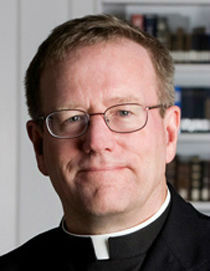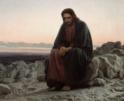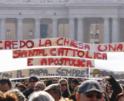
Spirituality
The extraordinary and mysterious Shroud of Turin speaks to us a great Easter truth -- namely, that at the heart of Christianity stands, not a myth or a legend or a symbol, but a fact, the bodily Resurrection of Jesus from the dead.

Barron
The Gospel for Easter Sunday is from St. John's account of Easter morning (John 20:1-9). We are told that Mary Magdalene arrives at the tomb very early in the morning while it is still dark. She has come to anoint the body of the Lord, which had been buried in haste because of the onset of the Passover. She spies the great stone rolled back and assumes that the body has been stolen. So she runs immediately to Simon Peter and the other disciples: "They have taken the Lord from the tomb, and we don't know where they put him." She doesn't yet believe in the Resurrection, for she is operating still within a conventional framework.
So the two disciples, Peter and John, make a mad dash toward the tomb, the younger John outpacing the older Peter. What an odd detail, by the way -- so peculiar in fact, that it led the novelist Graham Greene to accept the historicity of the account. Upon coming to the open tomb, John looks in and sees "the burial cloths." Then Peter arrives and spies the same cloths, as well as the cloth that had covered his head "rolled up in a separate place." Have you ever wondered why there is such an emphasis on the burial cloths? The most obvious reason is that their presence is peculiar. If the body had been stolen, why would the thieves have bothered taking the elaborately wound cloths off, and why in the world would they have taken the time and effort to fold the head cloth up so carefully?
But might they also be mentioned so prominently because they were treasured by the early Church? And might at least the principal cloth exist to this day? I'm speaking, of course, of the famous Shroud of Turin, which for centuries has been reverenced as a relic of the Crucifixion. I had a chance to see the shroud in 2010, when I was a visiting scholar in Rome and the cloth was exposed briefly for public display. It is remarkably long -- long enough indeed to have covered a body front and back. On it can be seen, plainly enough, rust-colored markings that suggest the frontal and dorsal sides of a man about 30 years of age. Marks of violence can be seen on him, wounds from whipping and, quite clearly, from crucifixion -- great gashes in the wrists and feet, as well as a gaping wound in the side of the torso.
However, the most remarkable feature of the shroud was revealed only in 1898, when it was photographed for the first time. When the photographer, a man named Secondo Pia, developed the film, he noticed that the negative of the photo revealed an exquisitely detailed depiction of the man of the shroud, anatomically exact to a degree that no artist could have produced. So, what we see of the shroud, he concluded, is itself a kind of photographic negative. And when scientists pored over the detailed version, what they saw took their breath away. Not only was the anatomy perfectly correct, but the details of the wounds were telling, corresponding to the very sort of scourges that ancient Romans used. The "crown" of thorns was more of a cap, and the wound in the side gave evidence of both blood and pericardial fluid: the blood and water that St. John spoke of. Furthermore, traces of coins, bearing the inscription of Pontius Pilate, could be seen covering the eyelids. Also, seeds and pollen from the Middle East were found within the strands of the fabric.
How was the image formed? Here, the scientists were truly stumped, for absolutely no trace of paint or pigment could be found, and the marks did not work their way down into the fabric but colored only the very surface of the shroud. The closest they could come to naming it accurately was to refer to it as a "scorch," something caused by an intense burst of radiation -- which would furthermore explain the photographic negative quality of the image.
What in nature would produce such a phenomenon? Nothing that we know. Does it indicate the fact of the Resurrection, when in a great burst of light and energy, the body of Jesus was brought back to life? The extraordinary and mysterious Shroud of Turin speaks to us a great Easter truth -- namely, that at the heart of Christianity stands, not a myth or a legend or a symbol, but a fact, the bodily Resurrection of Jesus from the dead. It was this historical truth that sent the first Christians careering around the world to announce the "Gospel," which means "good news." They were not trading in philosophical abstractions or spiritual musings; rather, they were grabbing their interlocutors by the shoulders and telling them that something had happened.
When St. John entered the tomb and saw the burial cloths, he "saw and believed." There was something about those wrappings that convinced him. I wonder whether the same thing is true today in our hyper-skeptical age. We, too, can see the cloth in which Jesus' body was wrapped, and we understand it far more thoroughly than St. John ever could have. Does it cause us to "see and believe?"
- Bishop Robert Barron is the founder of the global ministry, Word on Fire, and is Bishop of the Diocese of Winona-Rochester.
Recent articles in the Spirituality section
-
Why is Lent 40 days?Michael Pakaluk
-
The eloquent ambiguity of 'I believe'Bishop Robert Barron
-
You don't get what you pay forMichael Pakaluk
-
The witness of a consecrated lifeBishop Robert Barron
-
What is enlightenment? -- among angels and usMichael Pakaluk























